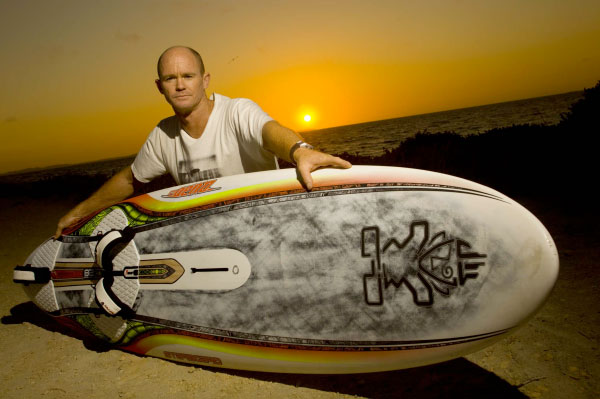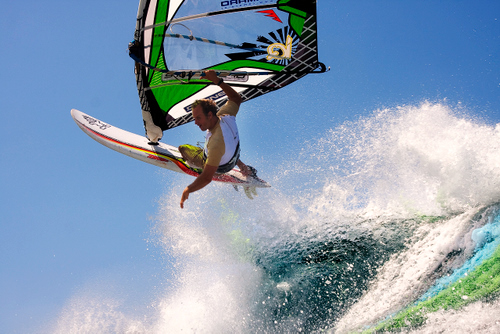Scott McKercher of Starboard reports on the development of this years Quad IQ.

Scott McKercher, head of wave board development, was loving the power being generated by the first generation Quads. For example, he talks about the boost out of the lip that is pretty much unequalled in any board the team has ever tried. But it didn’t have as good a vertical pivot in the lip type rotation. All it wanted to do was boost. Another was the fact that all the bite it provided through a turn didn’t enable the release type new school maneuvers like Takas and Backside 3s.
So from this starting point, Scott’s stage one was a smoother outline without hips utilizing the same fin configuration. A trip to Sumbawa was the test track for this with some pretty heavy waves out at Lakey Pipe. What the team discovered there was that taking out the hip with this rocker stiffened up the board too much, so some added rocker between the feet was needed to counter that.
It was back up to Bangkok to alter the rocker of prototype 1 before the next trip to Reunion Island. After a couple of sessions there with Scott, it was still feeling a little stiff. Looking at the curve and relating to how it felt, the next rocker cut was made in order to try to achieve that elusive combination of Power and Drive, whilst also being loose and smooth through an arc.
Scott’s hunches were correct, but then the feeling was that the tail was too wide in between the feet and back. Once again it was back to Bangkok for some outline modifications. This was where Scott felt that he was starting to get really close to a sensation that that people were going to appreciate. Boards that allow you to rip with ease.
It was on this test trip to Australia that the R&D team also started to mess around with fin placements and began to appreciate that different fin set ups were adept at doing things differently. Big fins forward were suiting onshore type conditions, providing better upwind performance and more explosive driven turns, while switching this around was feeling better down the line, providing a smoother sensation to the carve. Tiesda started to get busy trying to find a box system that was going to allow fin adaptability.
Up until then, all R&D was with a board that was 82 liters. The next stage was to apply all that was learned to be scaled into other sizes. No small feat by any means. This started the cycle of testing driving and flying between Bangkok Perth and the North West of Australia. Being Sept/Oct, it was necessary to drive 13 hours North to find wind and waves. It’s hard to remember how many times this was undertaken, as it became a bit of a travel blur. The number of long hour drives for R&D trips were countless.

But it was totally worthy as testing at Gnaraloo provides a couple of different waves in the one wave: upwind at Centre’s, it’s quite sideshore, requiring a lot of drive to make it back on yourself to hit the lip. Further down the line past the Bubbles/Tombie section, it becomes more side/off down the line.
Jaeger Stone came along to help out with driving and testing which was invaluable. One thing Scott has been learning most with the IQ adaptability concept is that everyone and every spot are different. What works for some people isn’t the same for someone else, so you have to involve a multi/person point of view. Svein Akerboom from Holland was also along for a couple of trips, as well as Severne product manager Simon Hurrey. All very accomplished sailors that had valuable input to provide.
Approaching the end of the Australian summer with further testing at places such as Margaret River and Esperance, the Starboard R&D team was finally getting all the sizes down. “A complete range made up of pretty damn fine boards”, affirms Scott. It was at this point that Ben Severne started to get into the mix asking if they wanted some help with playing around with different fin combinations. This collaboration ended up being the icing on the cake with a sensation that really blew the testers away down in Esperance. The board was now coming around so fluidly that Scott was 100% happy with what was going into production.
At this time, the Quad IQ 74, 77, 82, 87 and 92 were signed off. This was when Phillip Koster and Iballa Ruana Moreno were down in Oz for possibly the worst run of conditions in the history of Western Australia, right in the middle of our photo shoot. However, this resulted in the team ending up at a little sailed beach that looked incredibly like Vargus in Gran Canaria. Philip got to use the Quad IQ 82 to devastating effect. Back side and frontside 3s with full lay down bottom turns in onshore to vertical punches. Spectators were pretty much blown away, and the R&D team was ever more confident now that the new concept truly works in all conditions
This momentum was further confirmed at the photoshoot in Maui in the Spring. Team riders were incredibly happy with the boards, the new fins and the results.
Missing in the range was the smallest Quad IQ: the 69, which came right at the end of the process through a board that Swedish wavesailor/designer Ola Helenius left behind for the team to test. The smaller sailors in the team (Boujmaa and Anne Marie) fell in love with this board, and when Iballa and Daida put in a request for what they wanted to see in the smallest version of a Quad IQ, the little 69 designed by Ola ticked all the boxes. Available later towards September, the Quad IQ 69 completed the new line up.
Scott Mc Kercher wrapped up the year’s incredible R&D journey with this, “I’m pretty sure we’re going to make some people really happy once they get these under their feet”.
The Quad IQ: Starboard’s new adaptable wave board concept. Sizes 74, 77, 82, 87 and 92 are available from July 19th onwards. The Quad IQ 69 is available from late September onwards.


